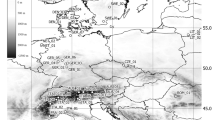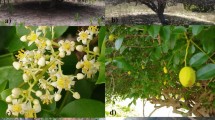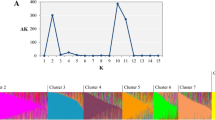Abstract
Analyses of four populations of Venturia inaequalis in Switzerland were performed to obtain information about migration and to predict the probable speed of the spread of new pathotypes able to overcome resistance, e.g. Vf-resistance, of new cultivars.
Genetic and haplotype diversity was calculated based on allele frequencies of random amplified polymorphic DNA (RAPD) markers and the internal transcribed spacer (ITS)-region of ribosomal DNA, which are regarded to be neutral, and the β-tubulin locus which may be under selection pressure. Within-population diversity was found to be quite similar over all four populations. Normalised haplotype diversity based on RAPD and ITS data was very high with a mean of 0.95. Diversity among populations (GST) was consistent over all neutral loci with a low mean of 0.04, but reached the high value of 0.26 for the selected β-tubulin locus. Low GST based on neutral loci may suggest a high level of gene flow.
Considering these results, new pathotypes would be expected soon outside their place of identification. But actual gene flow is easily overestimated because of effects of gene flow in the past. However, naturally occurring gene flow could be increased by human activity. Therefore, it is very difficult to predict durability of the Vf-resitance in Switzerland.
Similar content being viewed by others
References
Bühler M (1995) Reduktion der Fungizidbelastung in Obstanlagen: Einsatz einer standortbezogenen Bekämpfungsstrategie gegen den Apfelschorf (V. inaequalis). Diss ETH Nr 10985
Crosby JA, Janick J, Pecknold PC, Korban SS, O'Connor PA, Ries SM, Goffreda J and Voordeckers A (1992) Breeding apples for scab resistance: 1945–1990. Fruit Varieties Journal 46: 145–166
Frey CN and Keitt GW (1925) Studies of spore dissemination of Venturia inaequalis in relation to seasonal development of apple scab. Jour Agric Res 30: 529–540
Hartl LH and Clark AG (1989) Principles of population genetics. Second Edition. Sinauer associates, Sunderland, Massachusetts
Koenraadt H, Somerville SC and Jones, AL (1992) Characterization of mutations in the beta-tubulin gene of benomyl-resistant field strains of Venturia inaequalis and other plant pathogenic fungi. Phytopathology 82: 1348–1354
Koller B, Lehmann A, McDermott JM and Gessler C (1993) Identification of apple cultivars using RAPD markers. Theor Appl Genet 85: 901–904
Krebs CJ (1985) Ecology. The experimental analysis of distribution and abundance. Harper and Row, Cambridge
MacHardy WE (1996) Apple Scab. Biology, Epidemiology, and Management. APS Press, St. Paul, Minnesota Mills WD and Laplante AA(1951) Diseases and insects in the orchard. Cornell University Agricultural Experimental Station Bulletin 711: 21
Nei M 1973 Analysis of gene diversity in subdivided populations. Proc Natl Acad Sci 70 (12) Part I: 3321–332
Parisi L, Lespinasse Y, Guillaumes J, Krüger J (1993) A new race of Venturia inaequalis virulent to apples with resistance due to the Vf-gene. Phytopathology 83: 533–537
Roberts AL and Crute IR (1994) Apple scab resistance from Malus floribunda 821 (Vf) is rendered ineffective by isolates of Venturia inaequalis from Malus floribunda. Norwegian Journal of Agricultural Sciences. Supplement 17: 403–406
Sambrook J, F ritsch EF and Maniatis T (1989) Molecular cloning: a laboratory manual. 2nd edn. Cold Spring Harbor Laboratory, Cold Spring Harbor, New York
Sheldon AL (1969) Equitability indices: dependence on the species count. Ecology 50: 466–467
Sierotzki H, E ggenschwiler M, B oillat O, McDermott JM and Gessler C (1994) Detection of variation in virulence toward apple cultivars in natural populations of Venturia inaequalis. Phytopathology 84: 1005–1009
Slatkin M (1985) Gene flow in natural populations. Ann rev Ecol Syst 16: 393–430
Slatkin M (1987) Gene flow and the geographic structure of natural populations. Science 236: 787–792
Stanis VF and Jones AL (1984) Genetics of benomyl resistance in Venturia inaequalis from North and South America, Europe, and New Zealand. Can J Plant Pathol 6: 283–290
White TJ, Bruns T, Lee S and Taylor J (1990) Amplification and direct sequencing of fungal ribosomal RNA genes for phylogenetics. In: Innis MA and White TJ. PCR protocols: A guide to methods and applications (pp 315–322) Academic Press, San Diego, California
Wiesmann R (1932) Ueberwinterung des Apfelschorfpilzes Fusicladium dendriticum im toten Blatt sowie die Ausbreitung der Sommersporen des Apfelschorfpilzes. Landwirtschaftl Jahrbuch der Schweiz 46: 616–679
Workman PL and Niswander JD(1970) Population studies on Southwestern Indian tribes. II. Local genetic differentiation in the Papago. Am J Hum Genet 22: 24–29
Zolan ME and Pukkila PJ (1986) Inheritance of DNA methylation in Coprinus cinereus. Cell Biol 6: 195–200
Author information
Authors and Affiliations
Rights and permissions
About this article
Cite this article
Tenzer, I., Gessler, C. Subdivision and genetic structure of four populations of Venturia inaequalis in Switzerland. European Journal of Plant Pathology 103, 565–571 (1997). https://doi.org/10.1023/A:1008636913211
Issue Date:
DOI: https://doi.org/10.1023/A:1008636913211




